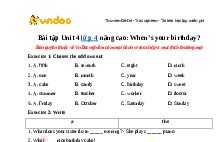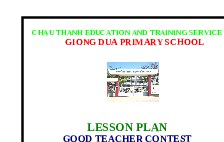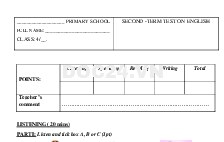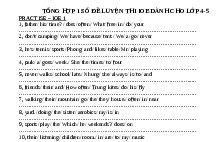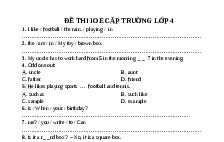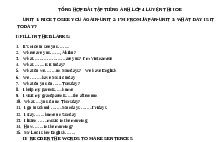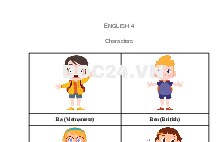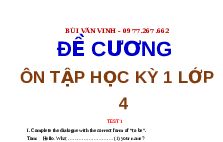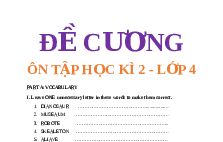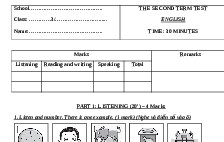Lớp 4 Smart Start 4 2017-2018
Nội dung tài liệu
Tải xuống
Link tài liệu:
Các tài liệu liên quan
-
![Bài tập Unit 4 Tiếng Anh lớp 4]()
-
![Lớp 4 Smart Start 4 2017-2018]()
-
![KIEM TRA TIENG ANH 4_HKII_TEST2]()
-
![Tổng hợp đề luyện thi IOE lớp 4 và 5]()
-
![Bài tập luyện thi IOE lớp 4]()
-
![Tổng hợp bài tập tiếng anh lớp 4 luyện thi IOE]()
-
![Scripts English 4 (U11 - 20)]()
-
![Đề cương ôn tập học kì 1 tiếng Anh lớp 4]()
-
![Đề cương ôn tập học kì 2 tiếng anh lớp 4]()
-
![Kiểm tra 1 tiết môn tiếng anh lớp 4]()
Có thể bạn quan tâm
Thông tin tài liệu
CHAU THANH EDUCATION AND TRAINING SERVICE
GIONG DUA PRIMARY SCHOOL
LESSON PLAN
GOOD TEACHER CONTEST
ENGLISH 4
Teacher’s name: Tran Thanh Phong
Schoolyear: 2017 – 2018
Teacher’s name: Tran Thanh Phong
School: Giong Dua Primary School
Week: 1 – Period: 1
Class: Giong Dua: 31,32,33
I learn Smart Start – Grade 4
Theme 1 – Numbers
The date of designing : August 14th, 2017
The date of teaching
: From: August 21st, 2017
To: August 25th, 2017
Theme 1: Numbers
Lesson 1
I. Objectives: Count from 1-10 and make a phone call
II. Teaching aids: - CD1 tracks 02-08
- Flashcards: zero, one, two, three, four, five, six, seven, eight, nine
III. Procedures:
Teacher & students’ activities
Child’s activities
Warm up. C. Listen. Sing along (CD1 - Track 06):
- listen
1. Play audio and have students listen.
2. Play audio and have students point to the pictures in Part A.
- song
3. Play audio and have students sing the song as a whole class.
4. Divide the class into two groups, group A sings the questions, group B
sings the answers.
5. Swap roles and repeat.
A. Listen, point and say (CD1 – Track 02):
- listen
1. Arrange the flashcards on the board, play audio and have students
listen and repeat. Point to the flashcards along with the audio. Repeat
- repeat
several times.
- point to the pictures
2. Play audio again and have students listen, repeat and point to the
pictures in their books.
- say
3. Change the order of the flashcards, point to them individually and
have students say the words, correct pronunciation when needed.
4. Divide the class into two teams. Play the game “Heads up. What's
- play game
missing?”. Arrange the flashcards on the board and remove one card
when students are not looking. One student from each team calls out the
missing flashcard.
B1. Listen and read (CD1 – Track 03):
- listen
1. Introduce the situation: “After a school trip...”
- read
2. Have students call out the numbers and people they can see.
3. Have students listen and read.
B2. Listen and circle (CD1 – Track 04):
1. Play audio and demonstrate the activity using the example.
- listen
2. Play audio and have students listen and circle.
- circle
3. Play audio again and check answers as a whole class.
B3. Practice the structure (CD1 – Track 05):
- practice
1. Draw students’ attention to the structure box.
2. Play audio and have students listen.
3. Play audio again and have students listen and repeat.
Pronunciation tip (CD1 – Track 07):
1. Focus on the example sentence and briefly explain the focus.
- listen
2. Tell students they must listen and notice the pronunciation feature.
3. Play the audio once and draw attention to the pronunciation feature.
4. Play the audio again. Have students listen and repeat with a focus on
the feature.
D. Listen and write. Ask and answer (CD1 – Track 08):
Listen and write.
1. Have students call out the people and numbers they can see.
2. Play audio and demonstrate the activity using the example.
3. Play audio again and have students listen and write.
4. Play audio again and check answers as a whole class.
Ask and answer.
5. Divide the class into pairs.
6. Have Student A point and ask, Student B answer.
7. Swap roles and repeat.
8. Afterwards, have some pairs demonstrate the activity in front of the
class.
E. Play the “Magic finger” game.
1. Demonstrate the game.
2. Divide the class into pairs.
3. Have Student A write ten numbers (0-9) on Student B’s back, using
their finger. Student B writes the numbers down.
4. Then have Student A ask “What’s your phone number?” and have
Student B answer using the numbers they have written down “It’s
_______.”
5. Afterwards, have some students demonstrate the activity in front of
the class.
Home- link:
- Learn and write new words and structures.
- Prepare for the next lesson
- repeat
- listen
- answer
- correct
- play game
- listen
Draw experience:
............................................................................................................................................................
............................................................................................................................................................
............................................................................................................................................................
Teacher’s name: Tran Thanh Phong
School: Giong Dua Primary School
Week: 1 – Period: 2
Class: Giong Dua: 31,32,33
I learn Smart Start – Grade 4
Theme 1 – Numbers
The date of designing : August 14th, 2017
The date of teaching
: From: August 21st, 2017
To: August 25th, 2017
Theme 1: Numbers
Lesson 2
I. Objectives: Count from 11-20 and talk about people's age
II. Teaching aids: - CD1 tracks 09-15
- Flashcards: eleven, twelve, thirteen, fourteen, fifteen, sixteen, seventeen, eighteen, nineteen,
twenty
III. Procedures:
Teacher & students’ activities
Child’s activities
Warm up- C. Listen. Sing along (CD1 – Track 13):
- listen
1. Play audio and have students listen.
2. Play audio and have students point to the pictures in Part A.
- song
3. Play audio and have students sing the song as a whole class.
4. Divide the class into two groups, group A sings the questions, group B
sings the answers.
5. Swap roles and repeat.
A. Listen, point and say (CD1 – Track 09):
- listen
1. Arrange the flashcards on the board, play audio and have students
listen and repeat. Point to the flashcards along with the audio. Repeat
- repeat
several times.
- point to the pictures
2. Play audio again and have students listen, repeat and point to the
pictures in their books.
- say
3. Change the order of the flashcards, point to them individually and
have students say the words, correct pronunciation when needed.
4. Play the “Guess” game. Arrange the flashcards on the board and write
- play game
a number under each card.
5. Have students look at the flashcards for the count of ten. Turn the
flashcards over to face the board when the students are not looking.
6. Call out a number and have students take turns to guess the face down
card. Turn the flashcard over after each guess.
B1. Listen and read (CD1 – Track 10):
1. Review the story from the previous lesson "After a school trip."
- listen
2. Now introduce the situation "Tom is asking how old people are…"
- read
3. Have students call out the objects and people they can see.
4. Have students listen and read.
B2. Listen and number (CD1 – Track 11):
1. Play audio and demonstrate the activity using the example.
2. Play audio and have students listen and write the numbers.
- listen
3. Play audio again and check answers as a whole class.
- number
B3. Practice the structure (CD1 – Track 12):
1. Draw students’ attention to the structure box.
- practice
2. Play audio and have students listen.
3. Play audio again and have students listen and repeat.
Pronunciation tip (CD1 – Track 14):
1. Focus on the example sentence and briefly explain the focus.
2. Tell students they must listen and notice the pronunciation feature.
3. Play the audio once and draw attention to the pronunciation feature.
4. Play the audio again. Have students listen and repeat with a focus on
the feature.
D. Listen and circle. Practice. Point, ask and answer (CD1 – Track
15):
Listen and circle.
1. Play audio and demonstrate the activity using the example.
2. Play audio and have students listen and circle.
3. Play audio again and check answers as a whole class.
Practice.
4. T: I say, ”he”. You say, "How old is he?"
T: I say , “they”. You say, "How old are they?" OK?
T: he
Class: How old is he?
T: they
Class: How old are they?
Continue whole class/group/individual drills, with:
• he • she • Tom • Lucy
5. Divide the class into Group A and Group B
6. Divide the class into pairs.
7. Have Student A point and ask and Student B answer.
8. Swap roles and repeat.
9. Afterwards, have some pairs demonstrate the activity in front of the
class.
E. Play the “Tic, tac, toe” game.
1. Divide the class into groups of four, with two students in each team.
2. Have teams play rock, paper, scissors. The winning team chooses a
square, asks and answers.
3. Have the teams take turns.
4. Swap roles and repeat until the game is finished.
5. Before the end of the lesson, check the answers as a whole class.
Home- link:
- Learn and write new words and structures.
- Prepare for the next lesson
- listen
- repeat
- listen
- answer
- practice
- play game
- listen
¬ Draw experience:
..............................................................................................................................................................
..............................................................................................................................................................
..............................................................................................................................................................
Teacher’s name: Tran Thanh Phong
School: Giong Dua Primary School
Week: 2 – Period: 3
Class: Giong Dua: 31,32,33
I learn Smart Start – Grade 4
Theme 1 – Numbers
The date of designing : August 21st, 2017
The date of teaching
: From: August 28th, 2017
To: September 1st, 2017
Theme 1: Numbers
Lesson 3
I. Objectives: Count up to 100 and do simple math
II. Teaching aids: - CD1 tracks 16-21
- Flashcards: thirty, forty, fifty, sixty, seventy, eighty, ninety, one hundred
III. Procedures:
Teacher & students’ activities
Child’s activities
Warm up- C. Listen. Sing along (CD1 – Track 20):
1. Play audio and have students listen.
- listen
- song
2. Play audio and have students point to the pictures in Part A.
3. Play audio and have students sing the song as a whole class.
4. Divide the class into two groups take turns singing the sentences.
5. Swap roles and repeat.
A. Listen, point and say (CD1 – Track 16):
1. Arrange the flashcards on the board, play audio and have students
- listen
listen and repeat. Point to the flashcards along with the audio. Repeat
several times.
- repeat
2. Play audio again and have students listen, repeat and point to the
- point to the pictures
pictures in their books.
3. Change the order of the flashcards, point to them individually and
- say
have students say the words, correct pronunciation when needed.
4. Divide the class into two teams. Play the game “Heads up. What's
missing?”. Arrange the flashcards on the board and remove one card
when students are not looking. One student from each team calls out the - play game
missing flashcard.
B1. Listen and read (CD1 – Track 17):
1. Review the story from the previous lesson "Tom was asking how old
- listen
people were."
- read
2. Now introduce the situation "The children are at the school fair..."
3. Have students call out the objects and people they can see.
4. Have students listen and read.
B2. Listen and write the numbers (CD1 – Track 18):
1. Play audio and demonstrate the activity using the example.
- listen
2. Play audio and have students listen and write the numbers.
- number
3. Play audio again and check answers as a whole class.
B3. Practice the structure (CD1 – Track 19):
1. Draw students’ attention to the structure box.
- practice
2. Play audio and have students listen.
3. Play audio again and have students listen and repeat.
Pronunciation tip (CD1 – Track 21):
1. Focus on the example sentence and briefly explain the focus.
2. Tell students they must listen and notice the pronunciation feature.
- listen
3. Play the audio once and draw attention to the pronunciation feature.
4. Play the audio again. Have students listen and repeat with a focus on
the feature.
D. Practice. Point and say.
Practice.
1. Divide the class into Group A and Group B
2. T: I say, ”twenty/thirty/is/fifty”. Group A, you say, “Twenty plus
thirty is …”. Group B, you say, “Fifty.”
T: I say, ”Twenty-five/five/is/thirty”. Group A, you say, “Twenty-five
plus five is ...”. Group B, you say, ”Thirty.”
T: twenty/thirty/is/fifty
Group A: Twenty plus thirty is …
Group B: Fifty.
T: Twenty-five/five/is/thirty
Continue whole class/group/individual
drills, with:
• ten/five/is/fifteen • ten/fifteen/is/twenty-five • forty/ten/is/fifty
Practice. Point and say.
3. Divide the class into pairs.
4. Have Student A point and say a statement, e.g. "Twenty plus thirty
is...". Have Student B say the result, e.g. "Fifty!".
5. Swap roles and repeat.
6. Afterwards, have some pairs demonstrate the activity in front of the
class.
E. Play the “Snake racing” game.
1. Divide the class into groups of four, with two students in each team.
2. Have teams play rock, paper, scissors. The winning team moves
forward two squares and the losing team moves forward one space.
3. Have teams take turns asking and answering. Swap roles and repeat
until the game is finished. (Rock, paper, scissors is played each turn)
4. Before the end of the lesson, check the answers as a whole class.
Home- link:
- Learn and write new words and structures.
- Prepare for the next lesson
- repeat
- listen
- answer
- practice
- play game
- listen
¬ Draw experience:
..............................................................................................................................................................
..............................................................................................................................................................
..............................................................................................................................................................
Teacher’s name: Tran Thanh Phong
School: Giong Dua Primary School
Week: 2 – Period: 4
Class: Giong Dua: 31,32,33
I learn Smart Start – Grade 4
Theme 1 – Numbers
The date of designing : August 21st, 2017
The date of teaching
: From: August 28th, 2017
To: September 1st, 2017
Theme 1: Numbers
Lesson 4
I. Objectives: Talk about the quantities of different things around me
II. Teaching aids: - CD1 tracks 22-27
- Flashcards: square, circle, triangle, rectangle, star, oval
III. Procedures:
Teacher & students’ activities
Child’s activities
Warm up- C. Listen. Sing along (CD1 – Track 26):
1. Play audio and have students listen.
- listen
- song
2. Play audio and have students point to the pictures in Part A.
3. Play audio and have students sing the song as a whole class.
4. Divide the class into two groups, group A sings the questions, group B
sings the answers.
5. Swap roles and repeat.
A. Listen, point and say (CD1 – Track 22):
- listen
1. Arrange the flashcards on the board, play audio and have students
listen and repeat. Point to the flashcards along with the audio. Repeat
- repeat
several times.
- point to the pictures
2. Play audio again and have students listen, repeat and point to the
pictures in their books.
- say
3. Change the order of the flashcards, point to them individually and
have students say the words, correct pronunciation when needed.
4. Play the “Word Tennis” game. Have one student come to the front and
- play game
play "Tennis" with you.
5. As you say a word hit it to the student and have the student respond
with another word and hit it back to you.
6. Divide the students into pairs and have them play with each other.
Have some pairs demonstrate the activity in front of the class.
B1. Listen and read (CD1 – Track 23):
1. Review the story from the previous lesson "The children were at the
- listen
school fair."
- read
2. Now introduce the situation "The children visit Lucy's art class..."
3. Have students call out the shapes and people they can see.
4. Have students listen and read.
B2. Listen and write the numbers (CD1 – Track 24):
1. Play audio and demonstrate the activity using the example.
2. Play audio and have students listen and write the numbers.
3. Play audio again and check answers as a whole class.
- listen
B3. Practice the structure (CD1 – Track 25):
- number
1. Draw students’ attention to the structure box.
2. Play audio and have students listen.
3. Play audio again and have students listen and repeat.
- practice
Pronunciation tip (CD1 – Track 27):
1. Focus on the example sentence and briefly explain the focus.
2. Tell students they must listen and notice the pronunciation feature.
3. Play the audio once and draw attention to the pronunciation feature.
4. Play the audio again. Have students listen and repeat with a focus on
the feature.
D. Count. Practice. Ask and answer.
Count.
1. Have students call out the shapes they can see.
2. Demonstrate the activity using the example.
3. Have students count the number of each shape they see in the picture.
4. Check answers as a whole class.
Practice.
5. T: I say, “squares”. You say, “How many squares can you see?”
T: I say, “circles”. You say, "How many circles can you see?” OK?
T: squares
Class: How many squares can you see?
T: circles
Class: How many circles can you see?
6. Divide the class into Group A and Group B
7. Divide the class into pairs.
8. Have Student A ask and Student B answer.
9. Swap roles and repeat.
10. Afterwards, have some pairs demonstrate the activity in front of the
class.
E. Look at D, play the “Memory” game.
1. Demonstrate the game.
2. Divide the class into pairs.
3. Have Student A look at the picture in Part D while Student B counts to
10.
4. Have Student B ask “How many_______ can you see?” Have Student
A answer with
“I can see ______ ______.”
5. Swap roles and repeat.
6. Afterwards, have some pairs demonstrate the activity in front of the
class.
Home- link:
- Learn and write new words and structures.
- Prepare for the next lesson
- listen
- repeat
- listen
- answer
- practice
- play game
- listen
¬ Draw experience:
..............................................................................................................................................................
..............................................................................................................................................................
..............................................................................................................................................................
Teacher’s name: Tran Thanh Phong
School: Giong Dua Primary School
Week: 3 – Period: 5+6
Class: Giong Dua: 31,32,33
I learn Smart Start – Grade 4
Theme 1 – Numbers
The date of designing : August 28th, 2017
The date of teaching : From: September 4th, 2017
To: September 8th, 2017
Theme 1: Numbers
Lesson 5
I. Objectives: Say thank you, offer food and drink, accept/refuse an offer and talk about food and
drink I like
II. Teaching aids: - CD1 tracks 28-30
- Flashcards: milk, juice, water, chicken, beef, chocolate
III. Procedures:
Teacher & students’ activities
Child’s activities
New words: Listen, point and say (CD1 – Track 28):
- listen
1. Arrange the flashcards on the board, play audio and have students
listen and repeat. Point to the flashcards along with the audio. Repeat
- say
several times.
2. Play audio again and have students listen, repeat and point to the
- listen
pictures in their books.
3. Change the order of the flashcards, point to them individually and
have students say the words, correct pronunciation when needed.
4. Divide the class into two teams. Play the game “Heads up. What's
- play game
missing?”. Arrange the flashcards on the board and remove one card
when students are not looking. One student from each team calls out the
missing flashcard.
Listening: Listen and put a tick or a cross in the box (CD1 – Track
29):
1. Introduce the topic “Value: Be polite.”
- listen
2. Play audio and demonstrate the activity using the example.
3. Play audio and have students put a tick or a cross in the box.
4. Play audio again and check answers as a whole class.
Useful language (CD1 – Track 30):
1. Have students look at the useful language box.
2. Have students listen to audio and repeat.
Reading: Read and circle “True” or “False”.
- listen
1. Have students read the text individually.
- repeat
2. Read the text as a whole class.
3. Demonstrate the activity using the example.
4. Have students read the questions and circle “True” or “False”.
- read
5. Check answers as a whole class.
- circle
Speaking: Ask and answer.
1. Demonstrate the activity using the example.
2. Divide the class into pairs.
3. Have Student A ask and Student B answer.
4. Swap roles and repeat.
5. Afterwards, have some pairs demonstrate the activity in front of the - practice
class.
Writing: Ask your friends and write their answers.
1. Demonstrate the activity.
2. Divide the class into pairs.
3. Have Student A ask and Student B answer. Have students write the
answers.
4. Swap roles and repeat. Afterwards, have some students read their
sentences in front of the class.
Home- link:
- Learn and write new words and structures.
- Prepare for the next lesson
- write
- listen
¬ Draw experience:
..............................................................................................................................................................
..............................................................................................................................................................
..............................................................................................................................................................
Teacher’s name: Tran Thanh Phong
School: Giong Dua Primary School
Week: 4 – Period: 7+8
Class: Giong Dua: 31,32,33
I learn Smart Start – Grade 4
Theme 1 – Numbers
The date of designing : September 4th, 2017
The date of teaching : From: September 11th, 2017
To: September 15th, 2017
Theme 1: Numbers
Lesson 6
I. Objectives: Review and practice
II. Teaching aids: - CD1 tracks 31-32
III. Procedures:
Teacher & students’ activities
Warm up:
Listen. Sing along (CD1 – Track 32):
1. Have students turn their Student’s Book to page 102.
2. Read lyrics as a whole class.
3. Play audio and have students listen.
4. Play audio again and have students listen and sing along.
Listen and draw lines (CD1 – Track 31):
1. Have students look at the pictures and call out the people and numbers
they can see.
2. Play audio and demonstrate the activity using the example.
3. Play audio and have students listen and draw lines.
4. Play audio again.
5. Play audio again and check answers as a whole class.
Look at the pictures. Look at the letters. Write the words.
1. Demonstrate the activity using the example on the board. Write the
mixed up letters on the board, then write the word “twelve” next to the
letters, cross out each letter once they have been put in the correct order.
2. Have students look at the mixed up letters and the pictures of
numbers. Have students spell the numbers in the spaces provided.
3. Check answers as a whole class.
4. Have some students demonstrate in front of the class.
Play the board game.
1. Demonstrate playing the game.
2. Divide the class into groups of four with two students in each team.
3. Have teams play rock, paper, scissors. The winning team goes forward
two spaces and the losing team goes forward one space.
4. Have students match the symbol to the structure and ask and answer
or practice (if the question or answer is incorrect, that team moves back
one space).
5. Swap roles and repeat until the game is finished (rock, paper, scissors
is played each turn).
6. Before the end of the lesson, check the answers as a whole class.
Home- link:
Child’s activities
- listen
- sing
- listen
- draw line
- read
- write
- play game
- Learn and write new words and structures.
- Prepare for the next lesson
- listen
¬ Draw experience:
..............................................................................................................................................................
..............................................................................................................................................................
..............................................................................................................................................................
Teacher’s name: Tran Thanh Phong
School: Giong Dua Primary School
Week: 5 – Period: 9
Class: Giong Dua: 31,32,33
I learn Smart Start – Grade 4
Theme 2: School
The date of designing : September 11th, 2017
The date of teaching : From: September 18th, 2017
To: September 22nd, 2017
Theme 2: School
Lesson 1
I. Objectives: Identify and talk about the location of school objects
II. Teaching aids: - CD1 tracks 33-39
- Flashcards: under, behind, next to, between, in front of
III. Procedures:
Teacher & students’ activities
Child’s activities
Warm up. C. Listen. Sing along (CD1 – Track 37):
1. Play audio and have students listen.
- listen
- song
2. Play audio and have students point to the pictures in Part A.
3. Play audio and have students sing the song as the whole class.
4. Divide class into two groups, group A sings the first sentence, group B
sings the second sentence.
5. Swap roles and repeat.
A. Listen, point and say (CD1 – Track 33):
- listen
1. Arrange the flashcards on the board, play audio and have students
listen and repeat. Point to the flashcards along with the audio. Repeat
- repeat
several times.
- point to the pictures
2. Play audio again and have students listen, repeat and point to the
pictures in their books.
- say
3. Change the order of the flashcards, point to them individually and
have students say the words, correct pronunciation when needed.
4. Play the “Guess” game. Arrange the flashcards on the board and write
- play game
a number under each card.
5. Have students look at the flashcards for the count of ten. Turn the
flashcards over to face the board when the students are not looking.
6. Call out a number and have students take turns to guess the face down
card. Turn the card over after each guess.
B1. Listen and read (CD1 – Track 34):
1. Now introduce the situation “Tom and Alfie tidy up the classroom…” - listen
- read
2. Have students call out the objects and people they can see.
3. Have students listen and read.
B2. Listen and number (CD1 – Track 35):
1. Play audio and demonstrate the activity using the example.
- listen
2. Play audio and have students listen and number.
- number
3. Play audio again and check answers as a whole class.
B3. Practice the structure (CD1 – Track 36):
1. Draw students’ attention to the structure box.
- practice
2. Play audio and have students listen.
3. Play audio again and have students listen and repeat.
Pronunciation tip (CD1 – Track 38):
1. Focus on the example sentence and briefly explain the focus.
2. Tell students they must listen and notice the pronunciation feature.
- listen
3. Play the audio once and draw attention to the pronunciation feature.
4. Play the audio again. Have students listen and repeat with a focus on
the feature.
D. Listen and draw lines. Practice. Point and say (CD1 – Track 39):
Listen and draw lines.
1. Demonstrate the activity using the example.
2. Play audio and have students listen and draw lines.
3. Play audio and check answers as a whole class.
Practice.
4. T: I say, “box/next to the cupboard”. You say, “Put the box next to the
cupboard, please.”
5. Demonstrate saying the statements.
6. Divide the class into pairs, have Student A point and Student B say.
7. Swap roles and repeat for next pictures.
8. Afterwards, have some pairs demonstrate the activity in front of the
class.
E. Play the “Tic, tac, toe” game.
1. Demonstrate playing the game.
2. Divide the class into groups of four, with two students in each team.
3. Have the teams play rock, paper, scissors. The winning team chooses
a square and says.
4. Have the teams take turns.
5. Swap roles and repeat until the game is finished.
6. Before the end of the lesson, check the answers as a whole class.
Home- link:
- Learn and write new words and structures.
- Prepare for the next lesson
- repeat
- listen
- draw line
- practice
- correct
- play game
- listen
¬ Draw experience:
..............................................................................................................................................................
..............................................................................................................................................................
..............................................................................................................................................................
GIONG DUA PRIMARY SCHOOL
LESSON PLAN
GOOD TEACHER CONTEST
ENGLISH 4
Teacher’s name: Tran Thanh Phong
Schoolyear: 2017 – 2018
Teacher’s name: Tran Thanh Phong
School: Giong Dua Primary School
Week: 1 – Period: 1
Class: Giong Dua: 31,32,33
I learn Smart Start – Grade 4
Theme 1 – Numbers
The date of designing : August 14th, 2017
The date of teaching
: From: August 21st, 2017
To: August 25th, 2017
Theme 1: Numbers
Lesson 1
I. Objectives: Count from 1-10 and make a phone call
II. Teaching aids: - CD1 tracks 02-08
- Flashcards: zero, one, two, three, four, five, six, seven, eight, nine
III. Procedures:
Teacher & students’ activities
Child’s activities
Warm up. C. Listen. Sing along (CD1 - Track 06):
- listen
1. Play audio and have students listen.
2. Play audio and have students point to the pictures in Part A.
- song
3. Play audio and have students sing the song as a whole class.
4. Divide the class into two groups, group A sings the questions, group B
sings the answers.
5. Swap roles and repeat.
A. Listen, point and say (CD1 – Track 02):
- listen
1. Arrange the flashcards on the board, play audio and have students
listen and repeat. Point to the flashcards along with the audio. Repeat
- repeat
several times.
- point to the pictures
2. Play audio again and have students listen, repeat and point to the
pictures in their books.
- say
3. Change the order of the flashcards, point to them individually and
have students say the words, correct pronunciation when needed.
4. Divide the class into two teams. Play the game “Heads up. What's
- play game
missing?”. Arrange the flashcards on the board and remove one card
when students are not looking. One student from each team calls out the
missing flashcard.
B1. Listen and read (CD1 – Track 03):
- listen
1. Introduce the situation: “After a school trip...”
- read
2. Have students call out the numbers and people they can see.
3. Have students listen and read.
B2. Listen and circle (CD1 – Track 04):
1. Play audio and demonstrate the activity using the example.
- listen
2. Play audio and have students listen and circle.
- circle
3. Play audio again and check answers as a whole class.
B3. Practice the structure (CD1 – Track 05):
- practice
1. Draw students’ attention to the structure box.
2. Play audio and have students listen.
3. Play audio again and have students listen and repeat.
Pronunciation tip (CD1 – Track 07):
1. Focus on the example sentence and briefly explain the focus.
- listen
2. Tell students they must listen and notice the pronunciation feature.
3. Play the audio once and draw attention to the pronunciation feature.
4. Play the audio again. Have students listen and repeat with a focus on
the feature.
D. Listen and write. Ask and answer (CD1 – Track 08):
Listen and write.
1. Have students call out the people and numbers they can see.
2. Play audio and demonstrate the activity using the example.
3. Play audio again and have students listen and write.
4. Play audio again and check answers as a whole class.
Ask and answer.
5. Divide the class into pairs.
6. Have Student A point and ask, Student B answer.
7. Swap roles and repeat.
8. Afterwards, have some pairs demonstrate the activity in front of the
class.
E. Play the “Magic finger” game.
1. Demonstrate the game.
2. Divide the class into pairs.
3. Have Student A write ten numbers (0-9) on Student B’s back, using
their finger. Student B writes the numbers down.
4. Then have Student A ask “What’s your phone number?” and have
Student B answer using the numbers they have written down “It’s
_______.”
5. Afterwards, have some students demonstrate the activity in front of
the class.
Home- link:
- Learn and write new words and structures.
- Prepare for the next lesson
- repeat
- listen
- answer
- correct
- play game
- listen
Draw experience:
............................................................................................................................................................
............................................................................................................................................................
............................................................................................................................................................
Teacher’s name: Tran Thanh Phong
School: Giong Dua Primary School
Week: 1 – Period: 2
Class: Giong Dua: 31,32,33
I learn Smart Start – Grade 4
Theme 1 – Numbers
The date of designing : August 14th, 2017
The date of teaching
: From: August 21st, 2017
To: August 25th, 2017
Theme 1: Numbers
Lesson 2
I. Objectives: Count from 11-20 and talk about people's age
II. Teaching aids: - CD1 tracks 09-15
- Flashcards: eleven, twelve, thirteen, fourteen, fifteen, sixteen, seventeen, eighteen, nineteen,
twenty
III. Procedures:
Teacher & students’ activities
Child’s activities
Warm up- C. Listen. Sing along (CD1 – Track 13):
- listen
1. Play audio and have students listen.
2. Play audio and have students point to the pictures in Part A.
- song
3. Play audio and have students sing the song as a whole class.
4. Divide the class into two groups, group A sings the questions, group B
sings the answers.
5. Swap roles and repeat.
A. Listen, point and say (CD1 – Track 09):
- listen
1. Arrange the flashcards on the board, play audio and have students
listen and repeat. Point to the flashcards along with the audio. Repeat
- repeat
several times.
- point to the pictures
2. Play audio again and have students listen, repeat and point to the
pictures in their books.
- say
3. Change the order of the flashcards, point to them individually and
have students say the words, correct pronunciation when needed.
4. Play the “Guess” game. Arrange the flashcards on the board and write
- play game
a number under each card.
5. Have students look at the flashcards for the count of ten. Turn the
flashcards over to face the board when the students are not looking.
6. Call out a number and have students take turns to guess the face down
card. Turn the flashcard over after each guess.
B1. Listen and read (CD1 – Track 10):
1. Review the story from the previous lesson "After a school trip."
- listen
2. Now introduce the situation "Tom is asking how old people are…"
- read
3. Have students call out the objects and people they can see.
4. Have students listen and read.
B2. Listen and number (CD1 – Track 11):
1. Play audio and demonstrate the activity using the example.
2. Play audio and have students listen and write the numbers.
- listen
3. Play audio again and check answers as a whole class.
- number
B3. Practice the structure (CD1 – Track 12):
1. Draw students’ attention to the structure box.
- practice
2. Play audio and have students listen.
3. Play audio again and have students listen and repeat.
Pronunciation tip (CD1 – Track 14):
1. Focus on the example sentence and briefly explain the focus.
2. Tell students they must listen and notice the pronunciation feature.
3. Play the audio once and draw attention to the pronunciation feature.
4. Play the audio again. Have students listen and repeat with a focus on
the feature.
D. Listen and circle. Practice. Point, ask and answer (CD1 – Track
15):
Listen and circle.
1. Play audio and demonstrate the activity using the example.
2. Play audio and have students listen and circle.
3. Play audio again and check answers as a whole class.
Practice.
4. T: I say, ”he”. You say, "How old is he?"
T: I say , “they”. You say, "How old are they?" OK?
T: he
Class: How old is he?
T: they
Class: How old are they?
Continue whole class/group/individual drills, with:
• he • she • Tom • Lucy
5. Divide the class into Group A and Group B
6. Divide the class into pairs.
7. Have Student A point and ask and Student B answer.
8. Swap roles and repeat.
9. Afterwards, have some pairs demonstrate the activity in front of the
class.
E. Play the “Tic, tac, toe” game.
1. Divide the class into groups of four, with two students in each team.
2. Have teams play rock, paper, scissors. The winning team chooses a
square, asks and answers.
3. Have the teams take turns.
4. Swap roles and repeat until the game is finished.
5. Before the end of the lesson, check the answers as a whole class.
Home- link:
- Learn and write new words and structures.
- Prepare for the next lesson
- listen
- repeat
- listen
- answer
- practice
- play game
- listen
¬ Draw experience:
..............................................................................................................................................................
..............................................................................................................................................................
..............................................................................................................................................................
Teacher’s name: Tran Thanh Phong
School: Giong Dua Primary School
Week: 2 – Period: 3
Class: Giong Dua: 31,32,33
I learn Smart Start – Grade 4
Theme 1 – Numbers
The date of designing : August 21st, 2017
The date of teaching
: From: August 28th, 2017
To: September 1st, 2017
Theme 1: Numbers
Lesson 3
I. Objectives: Count up to 100 and do simple math
II. Teaching aids: - CD1 tracks 16-21
- Flashcards: thirty, forty, fifty, sixty, seventy, eighty, ninety, one hundred
III. Procedures:
Teacher & students’ activities
Child’s activities
Warm up- C. Listen. Sing along (CD1 – Track 20):
1. Play audio and have students listen.
- listen
- song
2. Play audio and have students point to the pictures in Part A.
3. Play audio and have students sing the song as a whole class.
4. Divide the class into two groups take turns singing the sentences.
5. Swap roles and repeat.
A. Listen, point and say (CD1 – Track 16):
1. Arrange the flashcards on the board, play audio and have students
- listen
listen and repeat. Point to the flashcards along with the audio. Repeat
several times.
- repeat
2. Play audio again and have students listen, repeat and point to the
- point to the pictures
pictures in their books.
3. Change the order of the flashcards, point to them individually and
- say
have students say the words, correct pronunciation when needed.
4. Divide the class into two teams. Play the game “Heads up. What's
missing?”. Arrange the flashcards on the board and remove one card
when students are not looking. One student from each team calls out the - play game
missing flashcard.
B1. Listen and read (CD1 – Track 17):
1. Review the story from the previous lesson "Tom was asking how old
- listen
people were."
- read
2. Now introduce the situation "The children are at the school fair..."
3. Have students call out the objects and people they can see.
4. Have students listen and read.
B2. Listen and write the numbers (CD1 – Track 18):
1. Play audio and demonstrate the activity using the example.
- listen
2. Play audio and have students listen and write the numbers.
- number
3. Play audio again and check answers as a whole class.
B3. Practice the structure (CD1 – Track 19):
1. Draw students’ attention to the structure box.
- practice
2. Play audio and have students listen.
3. Play audio again and have students listen and repeat.
Pronunciation tip (CD1 – Track 21):
1. Focus on the example sentence and briefly explain the focus.
2. Tell students they must listen and notice the pronunciation feature.
- listen
3. Play the audio once and draw attention to the pronunciation feature.
4. Play the audio again. Have students listen and repeat with a focus on
the feature.
D. Practice. Point and say.
Practice.
1. Divide the class into Group A and Group B
2. T: I say, ”twenty/thirty/is/fifty”. Group A, you say, “Twenty plus
thirty is …”. Group B, you say, “Fifty.”
T: I say, ”Twenty-five/five/is/thirty”. Group A, you say, “Twenty-five
plus five is ...”. Group B, you say, ”Thirty.”
T: twenty/thirty/is/fifty
Group A: Twenty plus thirty is …
Group B: Fifty.
T: Twenty-five/five/is/thirty
Continue whole class/group/individual
drills, with:
• ten/five/is/fifteen • ten/fifteen/is/twenty-five • forty/ten/is/fifty
Practice. Point and say.
3. Divide the class into pairs.
4. Have Student A point and say a statement, e.g. "Twenty plus thirty
is...". Have Student B say the result, e.g. "Fifty!".
5. Swap roles and repeat.
6. Afterwards, have some pairs demonstrate the activity in front of the
class.
E. Play the “Snake racing” game.
1. Divide the class into groups of four, with two students in each team.
2. Have teams play rock, paper, scissors. The winning team moves
forward two squares and the losing team moves forward one space.
3. Have teams take turns asking and answering. Swap roles and repeat
until the game is finished. (Rock, paper, scissors is played each turn)
4. Before the end of the lesson, check the answers as a whole class.
Home- link:
- Learn and write new words and structures.
- Prepare for the next lesson
- repeat
- listen
- answer
- practice
- play game
- listen
¬ Draw experience:
..............................................................................................................................................................
..............................................................................................................................................................
..............................................................................................................................................................
Teacher’s name: Tran Thanh Phong
School: Giong Dua Primary School
Week: 2 – Period: 4
Class: Giong Dua: 31,32,33
I learn Smart Start – Grade 4
Theme 1 – Numbers
The date of designing : August 21st, 2017
The date of teaching
: From: August 28th, 2017
To: September 1st, 2017
Theme 1: Numbers
Lesson 4
I. Objectives: Talk about the quantities of different things around me
II. Teaching aids: - CD1 tracks 22-27
- Flashcards: square, circle, triangle, rectangle, star, oval
III. Procedures:
Teacher & students’ activities
Child’s activities
Warm up- C. Listen. Sing along (CD1 – Track 26):
1. Play audio and have students listen.
- listen
- song
2. Play audio and have students point to the pictures in Part A.
3. Play audio and have students sing the song as a whole class.
4. Divide the class into two groups, group A sings the questions, group B
sings the answers.
5. Swap roles and repeat.
A. Listen, point and say (CD1 – Track 22):
- listen
1. Arrange the flashcards on the board, play audio and have students
listen and repeat. Point to the flashcards along with the audio. Repeat
- repeat
several times.
- point to the pictures
2. Play audio again and have students listen, repeat and point to the
pictures in their books.
- say
3. Change the order of the flashcards, point to them individually and
have students say the words, correct pronunciation when needed.
4. Play the “Word Tennis” game. Have one student come to the front and
- play game
play "Tennis" with you.
5. As you say a word hit it to the student and have the student respond
with another word and hit it back to you.
6. Divide the students into pairs and have them play with each other.
Have some pairs demonstrate the activity in front of the class.
B1. Listen and read (CD1 – Track 23):
1. Review the story from the previous lesson "The children were at the
- listen
school fair."
- read
2. Now introduce the situation "The children visit Lucy's art class..."
3. Have students call out the shapes and people they can see.
4. Have students listen and read.
B2. Listen and write the numbers (CD1 – Track 24):
1. Play audio and demonstrate the activity using the example.
2. Play audio and have students listen and write the numbers.
3. Play audio again and check answers as a whole class.
- listen
B3. Practice the structure (CD1 – Track 25):
- number
1. Draw students’ attention to the structure box.
2. Play audio and have students listen.
3. Play audio again and have students listen and repeat.
- practice
Pronunciation tip (CD1 – Track 27):
1. Focus on the example sentence and briefly explain the focus.
2. Tell students they must listen and notice the pronunciation feature.
3. Play the audio once and draw attention to the pronunciation feature.
4. Play the audio again. Have students listen and repeat with a focus on
the feature.
D. Count. Practice. Ask and answer.
Count.
1. Have students call out the shapes they can see.
2. Demonstrate the activity using the example.
3. Have students count the number of each shape they see in the picture.
4. Check answers as a whole class.
Practice.
5. T: I say, “squares”. You say, “How many squares can you see?”
T: I say, “circles”. You say, "How many circles can you see?” OK?
T: squares
Class: How many squares can you see?
T: circles
Class: How many circles can you see?
6. Divide the class into Group A and Group B
7. Divide the class into pairs.
8. Have Student A ask and Student B answer.
9. Swap roles and repeat.
10. Afterwards, have some pairs demonstrate the activity in front of the
class.
E. Look at D, play the “Memory” game.
1. Demonstrate the game.
2. Divide the class into pairs.
3. Have Student A look at the picture in Part D while Student B counts to
10.
4. Have Student B ask “How many_______ can you see?” Have Student
A answer with
“I can see ______ ______.”
5. Swap roles and repeat.
6. Afterwards, have some pairs demonstrate the activity in front of the
class.
Home- link:
- Learn and write new words and structures.
- Prepare for the next lesson
- listen
- repeat
- listen
- answer
- practice
- play game
- listen
¬ Draw experience:
..............................................................................................................................................................
..............................................................................................................................................................
..............................................................................................................................................................
Teacher’s name: Tran Thanh Phong
School: Giong Dua Primary School
Week: 3 – Period: 5+6
Class: Giong Dua: 31,32,33
I learn Smart Start – Grade 4
Theme 1 – Numbers
The date of designing : August 28th, 2017
The date of teaching : From: September 4th, 2017
To: September 8th, 2017
Theme 1: Numbers
Lesson 5
I. Objectives: Say thank you, offer food and drink, accept/refuse an offer and talk about food and
drink I like
II. Teaching aids: - CD1 tracks 28-30
- Flashcards: milk, juice, water, chicken, beef, chocolate
III. Procedures:
Teacher & students’ activities
Child’s activities
New words: Listen, point and say (CD1 – Track 28):
- listen
1. Arrange the flashcards on the board, play audio and have students
listen and repeat. Point to the flashcards along with the audio. Repeat
- say
several times.
2. Play audio again and have students listen, repeat and point to the
- listen
pictures in their books.
3. Change the order of the flashcards, point to them individually and
have students say the words, correct pronunciation when needed.
4. Divide the class into two teams. Play the game “Heads up. What's
- play game
missing?”. Arrange the flashcards on the board and remove one card
when students are not looking. One student from each team calls out the
missing flashcard.
Listening: Listen and put a tick or a cross in the box (CD1 – Track
29):
1. Introduce the topic “Value: Be polite.”
- listen
2. Play audio and demonstrate the activity using the example.
3. Play audio and have students put a tick or a cross in the box.
4. Play audio again and check answers as a whole class.
Useful language (CD1 – Track 30):
1. Have students look at the useful language box.
2. Have students listen to audio and repeat.
Reading: Read and circle “True” or “False”.
- listen
1. Have students read the text individually.
- repeat
2. Read the text as a whole class.
3. Demonstrate the activity using the example.
4. Have students read the questions and circle “True” or “False”.
- read
5. Check answers as a whole class.
- circle
Speaking: Ask and answer.
1. Demonstrate the activity using the example.
2. Divide the class into pairs.
3. Have Student A ask and Student B answer.
4. Swap roles and repeat.
5. Afterwards, have some pairs demonstrate the activity in front of the - practice
class.
Writing: Ask your friends and write their answers.
1. Demonstrate the activity.
2. Divide the class into pairs.
3. Have Student A ask and Student B answer. Have students write the
answers.
4. Swap roles and repeat. Afterwards, have some students read their
sentences in front of the class.
Home- link:
- Learn and write new words and structures.
- Prepare for the next lesson
- write
- listen
¬ Draw experience:
..............................................................................................................................................................
..............................................................................................................................................................
..............................................................................................................................................................
Teacher’s name: Tran Thanh Phong
School: Giong Dua Primary School
Week: 4 – Period: 7+8
Class: Giong Dua: 31,32,33
I learn Smart Start – Grade 4
Theme 1 – Numbers
The date of designing : September 4th, 2017
The date of teaching : From: September 11th, 2017
To: September 15th, 2017
Theme 1: Numbers
Lesson 6
I. Objectives: Review and practice
II. Teaching aids: - CD1 tracks 31-32
III. Procedures:
Teacher & students’ activities
Warm up:
Listen. Sing along (CD1 – Track 32):
1. Have students turn their Student’s Book to page 102.
2. Read lyrics as a whole class.
3. Play audio and have students listen.
4. Play audio again and have students listen and sing along.
Listen and draw lines (CD1 – Track 31):
1. Have students look at the pictures and call out the people and numbers
they can see.
2. Play audio and demonstrate the activity using the example.
3. Play audio and have students listen and draw lines.
4. Play audio again.
5. Play audio again and check answers as a whole class.
Look at the pictures. Look at the letters. Write the words.
1. Demonstrate the activity using the example on the board. Write the
mixed up letters on the board, then write the word “twelve” next to the
letters, cross out each letter once they have been put in the correct order.
2. Have students look at the mixed up letters and the pictures of
numbers. Have students spell the numbers in the spaces provided.
3. Check answers as a whole class.
4. Have some students demonstrate in front of the class.
Play the board game.
1. Demonstrate playing the game.
2. Divide the class into groups of four with two students in each team.
3. Have teams play rock, paper, scissors. The winning team goes forward
two spaces and the losing team goes forward one space.
4. Have students match the symbol to the structure and ask and answer
or practice (if the question or answer is incorrect, that team moves back
one space).
5. Swap roles and repeat until the game is finished (rock, paper, scissors
is played each turn).
6. Before the end of the lesson, check the answers as a whole class.
Home- link:
Child’s activities
- listen
- sing
- listen
- draw line
- read
- write
- play game
- Learn and write new words and structures.
- Prepare for the next lesson
- listen
¬ Draw experience:
..............................................................................................................................................................
..............................................................................................................................................................
..............................................................................................................................................................
Teacher’s name: Tran Thanh Phong
School: Giong Dua Primary School
Week: 5 – Period: 9
Class: Giong Dua: 31,32,33
I learn Smart Start – Grade 4
Theme 2: School
The date of designing : September 11th, 2017
The date of teaching : From: September 18th, 2017
To: September 22nd, 2017
Theme 2: School
Lesson 1
I. Objectives: Identify and talk about the location of school objects
II. Teaching aids: - CD1 tracks 33-39
- Flashcards: under, behind, next to, between, in front of
III. Procedures:
Teacher & students’ activities
Child’s activities
Warm up. C. Listen. Sing along (CD1 – Track 37):
1. Play audio and have students listen.
- listen
- song
2. Play audio and have students point to the pictures in Part A.
3. Play audio and have students sing the song as the whole class.
4. Divide class into two groups, group A sings the first sentence, group B
sings the second sentence.
5. Swap roles and repeat.
A. Listen, point and say (CD1 – Track 33):
- listen
1. Arrange the flashcards on the board, play audio and have students
listen and repeat. Point to the flashcards along with the audio. Repeat
- repeat
several times.
- point to the pictures
2. Play audio again and have students listen, repeat and point to the
pictures in their books.
- say
3. Change the order of the flashcards, point to them individually and
have students say the words, correct pronunciation when needed.
4. Play the “Guess” game. Arrange the flashcards on the board and write
- play game
a number under each card.
5. Have students look at the flashcards for the count of ten. Turn the
flashcards over to face the board when the students are not looking.
6. Call out a number and have students take turns to guess the face down
card. Turn the card over after each guess.
B1. Listen and read (CD1 – Track 34):
1. Now introduce the situation “Tom and Alfie tidy up the classroom…” - listen
- read
2. Have students call out the objects and people they can see.
3. Have students listen and read.
B2. Listen and number (CD1 – Track 35):
1. Play audio and demonstrate the activity using the example.
- listen
2. Play audio and have students listen and number.
- number
3. Play audio again and check answers as a whole class.
B3. Practice the structure (CD1 – Track 36):
1. Draw students’ attention to the structure box.
- practice
2. Play audio and have students listen.
3. Play audio again and have students listen and repeat.
Pronunciation tip (CD1 – Track 38):
1. Focus on the example sentence and briefly explain the focus.
2. Tell students they must listen and notice the pronunciation feature.
- listen
3. Play the audio once and draw attention to the pronunciation feature.
4. Play the audio again. Have students listen and repeat with a focus on
the feature.
D. Listen and draw lines. Practice. Point and say (CD1 – Track 39):
Listen and draw lines.
1. Demonstrate the activity using the example.
2. Play audio and have students listen and draw lines.
3. Play audio and check answers as a whole class.
Practice.
4. T: I say, “box/next to the cupboard”. You say, “Put the box next to the
cupboard, please.”
5. Demonstrate saying the statements.
6. Divide the class into pairs, have Student A point and Student B say.
7. Swap roles and repeat for next pictures.
8. Afterwards, have some pairs demonstrate the activity in front of the
class.
E. Play the “Tic, tac, toe” game.
1. Demonstrate playing the game.
2. Divide the class into groups of four, with two students in each team.
3. Have the teams play rock, paper, scissors. The winning team chooses
a square and says.
4. Have the teams take turns.
5. Swap roles and repeat until the game is finished.
6. Before the end of the lesson, check the answers as a whole class.
Home- link:
- Learn and write new words and structures.
- Prepare for the next lesson
- repeat
- listen
- draw line
- practice
- correct
- play game
- listen
¬ Draw experience:
..............................................................................................................................................................
..............................................................................................................................................................
..............................................................................................................................................................


